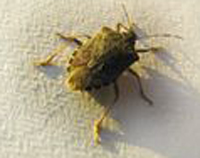|  Stink
Bugs Stink
Bugs
Order: Hemiptera
Family: Pentatomidae
Scientific Name: Halyomorpha halys
Color: Brown, Gray or Dark Green
Legs: Six
Shape: Body shaped like a shield
Size: 3/4 of an inch
Antennae: Yes
Flight: Yes
This insect, notorious for its "smelly" reputation, earned
its name from its tendency to release an odor when disturbed or
when crushed. Many other insects have these same characteristics,
including some species of ants, beetles and other bugs. Most stink
bugs are herbivorous and use their piercing and sucking mouthparts
to feed on plant juices. A few common species of stink bugs are
predatory and use their mouthparts to drain fluids from caterpillars
and other pest insects.
Habits
Most species of stink bugs are innocuous, only feeding on their
host plants, and are seldom encountered by humans. Stink bugs feed
on a variety of plants, including crop species. When stink bugs
feed on tree fruits such as apples, it results in a characteristic
distortion, referred to as "cat facing," that renders
the fruit unmarketable. Some species can cause damage in cotton
and other crops.
Predatory stink bugs use their mouthparts to drain fluids from
other pest insects. Some predatory stink bugs are important, beneficial
insects in crops and gardens. They prevent caterpillars and other
insect pests from destroying plants, trees, crops and gardens. Scientists
are interested in using them as natural control agents of crop pests.
When handled or disturbed, stink bugs are able to secrete a bad-smelling,
bad-tasting fluid from pores on the sides of their bodies. This
secretion protects stink bugs from predators. They are often fed
upon by birds, spiders, assassin bugs and other arthropod predators
(including other stink bugs). Many species are attracted to lights
at night. Adult stink bugs of various species are active from spring
through late fall.
Habitat
During warm months, female stink bugs attach large masses of eggs
to the underside of leaves and stems. After hatching, the wingless
nymphs go through five immature stages before becoming full-sized,
winged adults. Stink bugs are not known to bite humans but caution
should be used when handling them to avoid a release of their odor.
Threats
Considered a nuisance, although some of this species may be considered
agriculture pests because they suck juices from crop plants.
Control
To prevent stink bugs from entering homes and buildings, seal cracks
around windows, doors, siding, utility pipes, behind chimneys, and
underneath the wood fascia and other openings. Use a good quality
silicone or silicone-latex caulk. Damaged screens on doors and windows
should be repaired or replaced. A licensed pest professional can
treat for stink bugs in the late summer or fall just prior to bug
congregation.
If stink bugs have already entered a home or building, a vacuum
cleaner can aid in the removal of live or dead stink bugs. The bag
must be removed to prevent odor from permeating the area. If an
infestation has developed inside the home or building, a licensed
pest control operator should be called to evaluate and assess the
problem.
(Source: National Pest Management Association, et. al.)
|